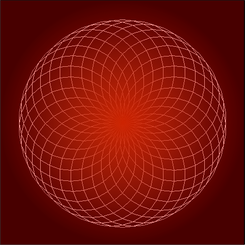 |
| Example Logo output |
Logo is an educational programming language, designed in 1967 by Daniel G. Bobrow, Wally Feurzeig, Seymour Papert and Cynthia Solomon. Today the language is remembered mainly for its use of "turtle graphics", in which commands for movement and drawing produced line graphics either on screen or with a small robot called a "turtle". The language was originally conceived to teach concepts of programming related to LISP and only later to enable what Papert called "body-syntonic reasoning" where students could understand (and predict and reason about) the turtle's motion by imagining what they would do if they were the turtle. There are substantial differences between the many dialects of Logo, and the situation is confused by the regular appearance of turtle graphics programs that mistakenly call themselves Logo.
Logo is a multi-paradigm adaptation and dialect of Lisp, a functional programming language. There is no standard Logo, but UCBLogo has best facilities for handling lists, files, I/O, and recursion in scripts, and can be used to teach all computer science concepts, as UC Berkeley lecturer Brian Harvey did in his Computer Science Logo Style trilogy. For tertiary level teaching, however, Logo has been superseded by Scheme, and scripting languages.
History
Logo was created in 1967 at Bolt, Beranek and Newman (BBN), at Cambridge, Massachusetts research firm, by Wally Feurzeig and Seymour Papert. Its intellectual roots are in artificial intelligence, mathematical logic and developmental psychology. The first four years of Logo research, development and teaching work was done at BBN. The first implementation of Logo, called Ghost, was written in LISP on a PDP-1. The goal was to create a math land where kids could play with words and sentences. Modeled on LISP, the design goals of Logo included accessible power and informative error messages. The use of virtual Turtles allowed for immediate visual feedback and debugging of graphic programming.
The first working Logo turtle robot was created in 1969. A display turtle preceded the physical floor turtle. Modern Logo has not changed too much from the basic concepts before the first turtle. The first turtle was a tethered floor roamer, not radio-controlled or wireless. At BBN Paul Wexelblat developed a turtle named Irving that had touch sensors and could move forwards, backwards, rotate, and ding its bell. The earliest year-long school users of Logo were in 1968-69 at Muzzey Jr High, Lexington MA. The virtual and physical turtles were first used by fifth graders at the Bridge School in Lexington, MA in 1970-71.
Name
"Logo" is not an acronym. It was derived from the Greek logos meaning word or "thought" by Feurzeig, to distinguish itself from other programming languages that were primarily numbers, not graphics or logic, oriented.
Design
Logo is usually an interpreted language, although there have been developed compiled Logo dialects—such as Lhogho or Liogo. Logo is not case-sensitive but retains the case used for formatting. It is a compromise between a sequential programming language with block structures, and a functional programming language.
Turtle and graphics
Logo's most-known feature is the turtle (derived originally from a robot of the same name),[6] an on-screen "cursor" that showed output from commands for movement and small retractable pen, together producing line graphics. It has traditionally been displayed either as a triangle or a turtle icon (though it can be represented by any icon). Turtle graphics were added to the Logo language by Seymour Papert in the late 1960s to support Papert's version of the turtle robot, a simple robot controlled from the user's workstation that is designed to carry out the drawing functions assigned to it using a small retractable pen set into or attached to the robot's body.
As a practical matter, the use of turtle geometry instead of a more traditional model mimics the actual movement logic of the turtle robot. The turtle moves with commands that are relative to its own position, LEFT 90 means spin left by 90 degrees. Some Logo implementations, particularly those that allow the use of concurrency and multiple turtles, support collision detection and allow the user to redefine the appearance of the turtle cursor, essentially allowing the Logo turtles to function as sprites.
Multiple turtles are supported by MSWLogo, as well as 3D graphics. Input from COM ports and LPT ports are also allowed by MSWLogo through windows GUI. Interrupts can be triggered via keyboard and mouse events. Simple GIF animations may also be produced on MSWLogo version 6.5 with the gifsave command.
Turtle geometry is also sometimes used in environments other than Logo as an alternative to a strictly coordinate-addressed graphics system. For instance, the idea of turtle graphics is also useful in Lindenmayer system for generating fractals.

